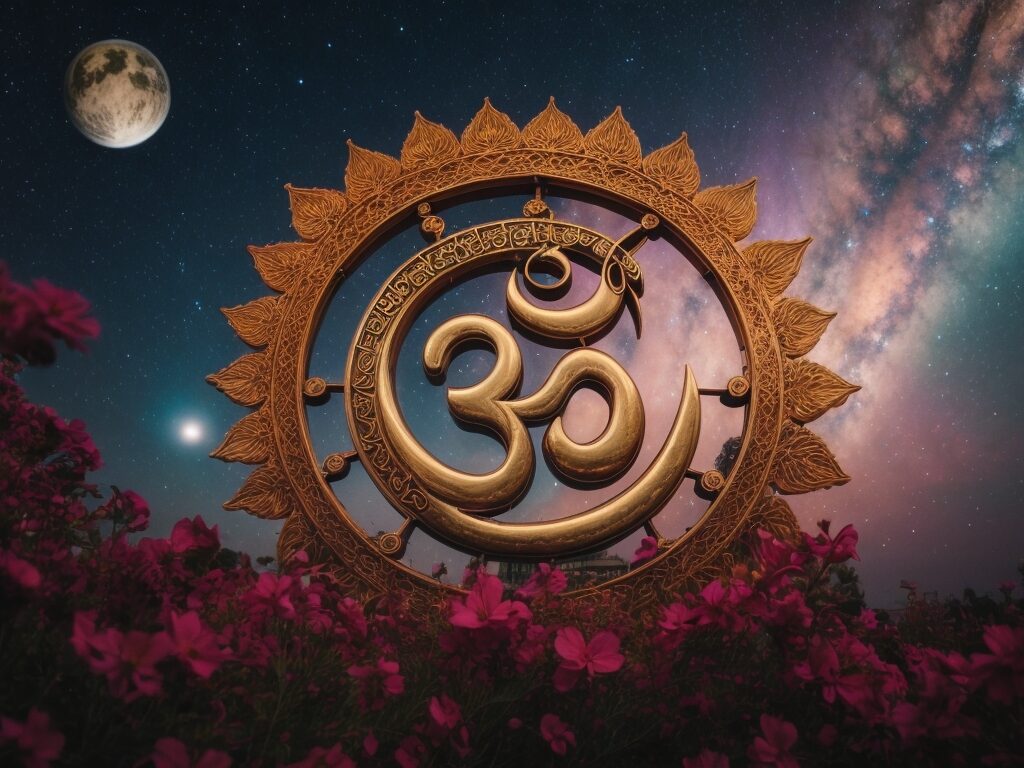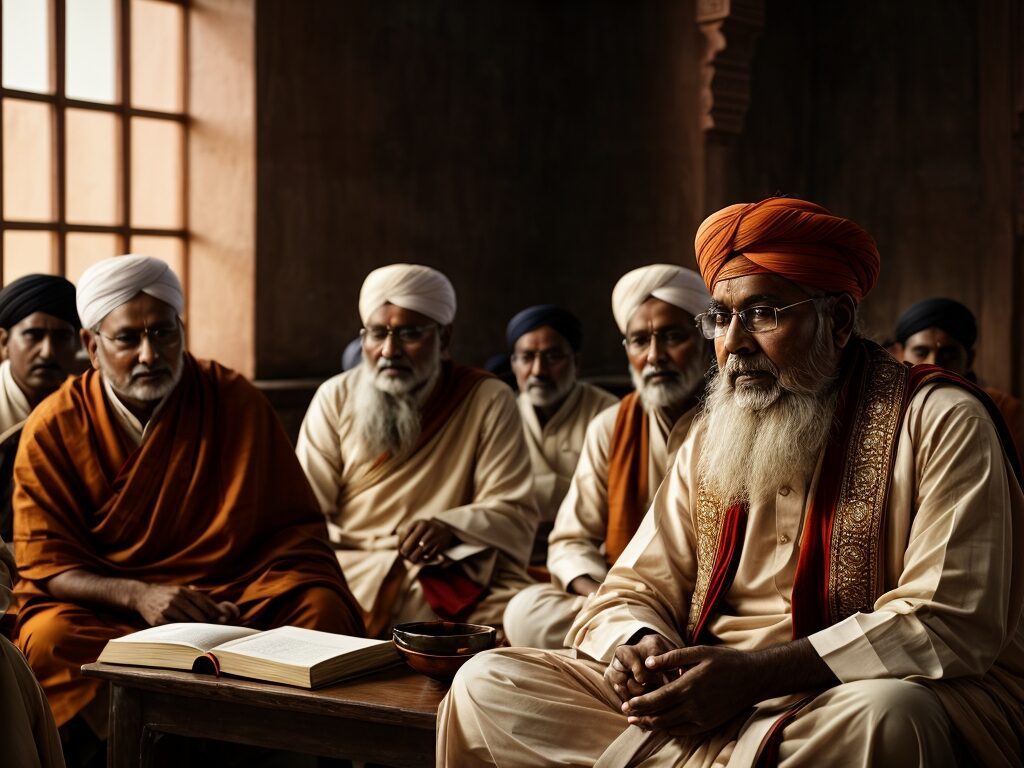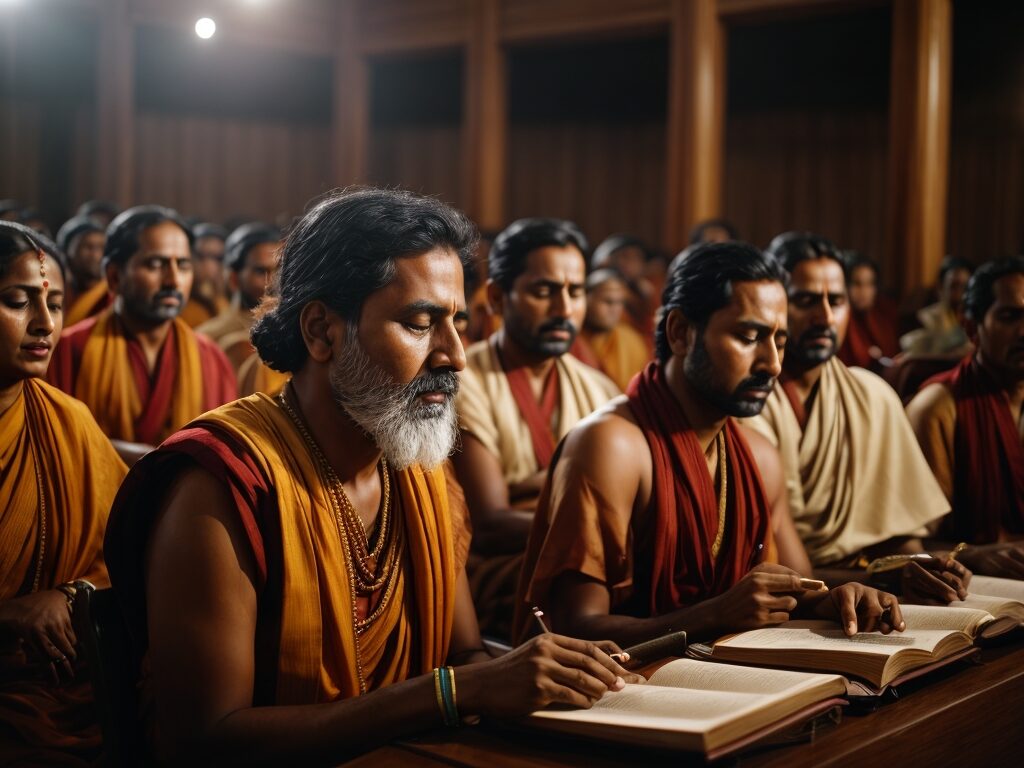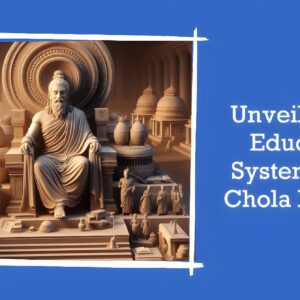Table of Contents
Rigveda: The Sacred Text of Vedic Sanskrit
The Rigveda, the oldest of the ancient Indian collections of Vedic Sanskrit hymns, holds a sacred place in Hinduism. Composed in an ancient form of Sanskrit during the Vedic period, the text is a repository of religious and philosophical wisdom, providing insights into the ancient Indian culture, beliefs, and the understanding of the universe. Rigveda, with its rich poetical value, offers a glimpse into the ancient way of life, the importance of religion, and the complexity of the divine. As we explore the significance, composition, organization, and interpretation of the Rigveda, we delve into the depths of ancient India’s religious and cultural heritage. The Rigveda originated in ancient India around 1800-1100 BCE.
Understanding the Rigveda

To truly grasp the significance of the Rigveda, it is crucial to understand its nature and purpose. Rigveda, often called the “Rig Veda,” is the earliest and most revered of the four Vedas, the ancient Indian collection of Vedic Sanskrit hymns. Composed in the Vedic period, which dates back thousands of years, the text represents the religious and philosophical beliefs of ancient India. It serves as a guide to the divine, providing hymns and verses dedicated to various deities, rituals, and the exploration of the cosmic order. The Rigveda is also known for its inclusion of the Aryankas, which are commonly referred to as the forest books.
The Significance of Rigveda in Hinduism
The Rigveda holds immense significance in Hinduism, the world’s third-largest religion. The hymns in the Rigveda encompass the foundational concepts of Hindu beliefs, serving as a spiritual guide for millions of people. They emphasize the importance of religion, morality, and the divine nature of the universe. The hymns portray the gods and goddesses of the Hindu pantheon, reflecting the ancient Indian culture and religious practices. Rigveda hymns have played a crucial role in shaping Hindu mythology, religious rites, and ceremonies, ensuring the continuity of ancient traditions to the present day.
The Rigveda provides insight into the multifaceted dimensions of Hinduism, including the philosophical, cosmological, and ritualistic aspects of the religion. It explores the concept of dharma, the moral and ethical duty that governs the individual and society, and lays the groundwork for the concept of karma, the cycle of cause and effect. The hymns of the Rigveda present the ancient seers’ observations on the world, the universe, and the divine, offering a profound understanding of the Hindu way of life. The text introduces the concept of Rta as the active realization of truth and cosmic harmony, which influenced the later Hindu concept of dharma. It also attributes the effect of Rta to Brahman, a profound and not self-evident truth.
Role and Influence of Rigveda on Indian Culture
The Rigveda holds a significant place in ancient Indian culture, particularly in the Punjab region of India, where it originated. The text is a testament to the poetical and literary heritage of ancient India, showcasing the profound influence of the Vedic period on the nation’s cultural fabric. The hymns of the Rigveda cover various topics, including love stories, philosophical questions, and the importance of religion in ancient Indian society. They provide a unique window into the daily life, customs, and societal structures of the Vedic age, serving as a valuable historical and anthropological resource.
Moreover, Rigveda hymns shed light on the significance of religious rituals and ceremonies in ancient India. They offer insights into the Vedic seers’ beliefs, practices, and the importance of maintaining a harmonious relationship with the divine forces. The hymns reflect the religious ceremonies, sacrifices, and adoration of gods and goddesses, showcasing the integral role of religion in ancient Indian culture. Rigveda hymns have captured the imagination of scholars, poets, and artists across generations, transcending time and enriching the world with their profound insights into ancient Indian beliefs and customs.
The Composition and Structure of Rigveda
The Rigveda, as the name suggests, is a collection of hymns known as suktas. It comprises 1,028 hymns, divided into ten books, called mandalas, forming the Rigveda Samhita. Each mandala has a length but interestingly the first and last ones both have 191 suktas. This intentional structure ensures that the spiritual knowledge, rituals and philosophical discussions present, in the Rigveda are preserved and can be handed down through generations allowing future seers to grasp the understanding of the divine.
The Rigveda Samhita comprises 10,552 Mantras, which are categorized into ten books known as Mandalas. Each Mandala is further divided into sections called Anuvakas. Each Anuvaka consists of hymns referred to as Suktas and each Sukta is composed of numerous verses called riks.
The Organization of Hymns in Rigveda
The hymns of Rigveda are carefully organized into mandalas, demonstrating the Vedic seers’ poetic and religious insights. Each mandala focuses on particular deities, religious ceremonies, or philosophical ideas, offering a comprehensive range of hymns dedicated to a wide array of gods and goddesses. The mandalas present a holistic view of the ancient Indian religious practices, providing hymns for various rituals, divine entities, and the exploration of the universe. The Atri clan, known for their compositions, has contributed to the hymns in Mandala 5, which are dedicated to Agni, Indra, Visvadevas, Maruts, Asvins, Mitra-Varuna, and the nadistuti sukta.
Furthermore, the hymns of the Rigveda are attributed to different rishis, or seers, who are acknowledged as the composers of the verses. These rishis, through deep meditation and divine revelations, embodied the divine wisdom present in the hymns. The rishis’ names associated with the hymns add a personal touch, acknowledging the seers’ spiritual contributions and underscoring the sacredness of the text.
The Unique Literary Features of Rigveda
The Rigveda stands out not only for its religious and philosophical significance but also for its unique literary features. Composed in the poetical Vedic Sanskrit, the text showcases the ancient form of the Sanskrit language, characterized by its rhythmic patterns, metaphors, and expressive verses. The hymns of the Rigveda are considered some of the most ancient and poetic compositions in the world, reflecting the immense creativity and linguistic prowess of the Vedic seers.
The hymns of the Rigveda employ various literary devices, including vivid imagery, epithets, and symbolic representations, to convey profound religious and philosophical ideas. The verses are meticulously crafted, with each word carrying multiple layers of meanings, giving the hymns a depth that transcends the boundaries of time and culture. This poetical value of the Rigveda plays a significant role in preserving the text’s enduring importance, captivating the hearts and minds of generations of devotees, scholars, and seekers of wisdom.
The Philosophical and Cosmological Questions Explored in Rigveda
The hymns of the Rigveda explore fundamental philosophical and cosmological questions, delving into the nature of the universe, the world, and existence itself. One of the most famous hymns, the “Nasadiya Sukta,” contemplates the origins of the universe and the divine forces at play. It poses deep existential questions, challenging the boundaries of human understanding and inviting contemplation on the mysteries of the cosmos. These matters are discussed in the hymns that deal with the concerns of that era. The collection is still regarded as sacred and revered today. Holds great significance, in Hindu tradition.

The Concept of Deities in Rigveda
The Rigveda contains hymns dedicated to various deities, revering gods and goddesses associated with different aspects of existence, including the Hindu deities. These hymns are devoted to the deities of the Rigveda and also touch upon cosmology. Today these verses are recited during specific ceremonies such, as weddings and religious prayers. The hymns are dedicated to various gods, the main ones being Indra, Agni, and Soma.
The Adityas, as well as Mitra-V. These deities, known as Hindu gods, are revered in Hinduism for their roles as protectors, creators, and upholders of the cosmic order. They include Indra, the god of thunder and rain, Agni, the god of fire, Surya, the sun god, Varuna, the god of the waters, and Vishnu, the preserver of the universe, among others.
The hymns in the Rigveda provide divine attributes, powers, and mythology associated with each particular deity, reflecting the ancient Indian beliefs of the Vedic period. These hymns present a vivid glimpse into the rich pantheon of gods and goddesses, allowing devotees to connect with the divine and engage in religious practices centred around specific deities, fostering a personal relationship with the divine forces of the universe.
The Depiction of Life and Society in Rigveda
The hymns of the Rigveda offer valuable insights into the life and society of ancient India during the Vedic age, particularly during the annual New Year Soma ritual. Rigveda hymns depict the daily routines, customs, rituals, and societal structures prevalent at the time, making the text a unique cultural and anthropological resource. The hymns celebrate the importance of religion, family, community, and the harmonious coexistence of human beings with nature.
The Rigveda presents an intricate web of religious, philosophical, and social customs, allowing us to understand the ancient Indian culture’s complexity. From love stories to treatises on governance, the hymns provide a holistic portrayal of the Vedic age, capturing the aspirations, beliefs, and aspirations of ancient Indian society. Through the hymns, we gain insight into the ancient Indian collection of hymns, providing a poetic window into the world of our ancestors and their cultural practices.
The Schools of Rigveda and Their Teachings

The Rigveda gave rise to different schools of thought, including the Upanishads, further enriching the religious and philosophical landscape of ancient India. The Rigveda Brahmana, a text associated with the Rigveda, contains the teachings, interpretations, and rituals performed by the Vedic seers, including the Upanishads. These teachings passed down through generations, shaped the religious, social, and cultural fabric of ancient Indian society, fostering a deeper understanding of the divine, the universe, and human existence. The first Vedic text was written in the Brahmi script, which was the most frequently spoken dialect at the time the language was recorded.
The Different Recensions of the Rigveda
The Rigveda is available in two major recensions, the Shakala and the Baskala, each associated with particular Vedic schools. The Shakala recension, the more prevalent of the two, consists of 1,017 hymns divided into ten mandalas. It is the most widely studied recension of the Rigveda. The Baskala recension, though less common, contains additional hymns that are not present in the Shakala recension. These recensions offer valuable insights into the diversity of oral traditions, religious ceremonies, and the interpretation of the ancient text, enriching our understanding of the Rigveda.
The Evolution of the Rigveda Over Centuries
The Rigveda, composed thousands of years ago, has undergone linguistic, stylistic, and philosophical changes over the centuries. The text, initially transmitted orally, evolved with the religious, social, and political landscapes of ancient India. As new hymns were added and the text organically grew, the Rigveda expanded to encompass various aspects of religious, philosophical, and metaphysical exploration. The text adapted to the changing dynamics of the Vedic age, reflecting the evolving understanding of the divine, the universe, and human existence.
Major Hymns of Rigveda and Their Interpretations

Within the vast collection of hymns, several stand out as major hymns in Rigveda. These hymns, through their poignant verses, present profound insights into various aspects of religious, philosophical, and societal life. Two examples include the hymns dedicated to the Fire God, Agni, and the Storm God, Indra.
Hymns Dedicated to Fire God Agni
The hymns dedicated to Agni, the Fire God, hold a special place in the Rigveda. Agni is revered as the messenger between humans and gods, carrying offerings and prayers to the divine realms. The hymns express reverence, seeking blessings, protection, and prosperity from the deity. Agni, the embodiment of fire, symbolizes the divine energy, purification, and the vital element for religious ceremonies. The hymns dedicated to Agni showcase the importance of the Fire God in the ancient Indian culture, underscoring the religious and spiritual significance of the Rigveda.
Hymns Dedicated to Storm God Indra
The hymns dedicated to Indra, the powerful Storm God, are among the most celebrated in Rigveda. Indra is depicted as the slayer of demons, the protector of the universe, and the bestower of rain and prosperity. The hymns exalt his heroic feats, valour in battles, and his divine role in upholding the cosmic order. Indra’s portrayal in the hymns embodies the ancient Indian concept of divine sovereignty and the triumph of good over evil. Through these hymns, the Rigveda offers a vivid depiction of the mythical narratives and the wide range of deities revered by the Vedic seers.
The Transmission and Preservation of Rigveda

The Rigveda, preserved and transmitted over thousands of years, showcases the ancient Indian commitment to maintaining the purity of the text. The seers, through the oral tradition, memorized and recited the hymns, ensuring the text’s continued existence and accuracy. The transmission of the Rigveda relied on precise enunciation, intonation, and mnemonic techniques, safeguarding the original text. The oral tradition fostered a deep spiritual connection between the seers and the divine verses, reinforcing the sacredness of the Rigveda and its role in religious ceremonies, rituals, and the dissemination of religious knowledge.
The Oral Tradition and Techniques Used for Preservation
The Rigveda’s preservation through the centuries relied on the oral tradition, where the hymns were memorized, recited, and passed down from one generation to the next. This traditional approach to transmission ensured the text’s purity, integrity, and accuracy. The Vedic seers employed various mnemonic techniques and rhythmic patterns to aid in precisely recollecting the verses, and preserving the original text’s structure, sound, and pronunciation.
- Rhythmic patterns and mnemonic devices aided accurate recollection
- Chanting and reciting facilitated the preservation of the text
- Precise enunciation and careful intonation carried the sacred essence of the verses
- Continuous practices of recitation in religious ceremonies maintained the text’s revered status
- The devotional commitment of the seers and their connection with the divine preserved the spiritual heritage of the Rigveda.
The Role of Brahmanas in the Dissemination of Rigveda
The dissemination of the Rigveda, while primarily preserved through the oral tradition, owes much to the efforts of the Brahmanas, the priestly class of ancient India. The Brahmanas, through their scholarly exegesis, interpreted the religious, ritualistic, and philosophical aspects of the Rigveda, ensuring its comprehension and propagation. The Brahmanas closely collaborated with the Vedic seers, disseminating the knowledge of the Rigveda during religious ceremonies, rituals, and the performance of Vedic rites. Their role expanded beyond the mere transmission of the text, as they contributed to the understanding, explanation, and preservation of the Rigveda, affirming the text’s significant role in ancient Indian religious practices and the interconnectedness of the Vedic seers and the religious text.
What is the Rigveda and why is it important?
The Rigveda is a collection of ancient Indian hymns and prayers in Vedic Sanskrit. It is one of the oldest sacred texts of Hinduism and holds immense religious and cultural significance. It provides insights into the early beliefs, rituals, and social structures of the Vedic period.
How has Modern Scholarship Influenced our Understanding of Rigveda?
Modern scholarship has revolutionized our understanding of the Rigveda, shedding new light on the text’s historical, religious, and cultural significance. Through philological, archaeological, and comparative methodologies, scholars have delved into the linguistic evolution, religious beliefs, and the societal framework reflected in the Rigveda. These interdisciplinary approaches have deepened our appreciation of the text, enabling a more nuanced interpretation of the religious, philosophical, and poetic dimensions of the Rigveda.
- Philological, archaeological, and comparative methods uncover the historical and cultural contexts of the Rigveda
- Linguistic analysis explores the evolution of the ancient Sanskrit language and its impact on the text
- Comparative studies with other ancient civilizations reveal the interconnectedness of the Rigveda with the broader cultural tapestry of humanity
- Contemporary research expands our understanding of the religious practices, beliefs, and rituals of ancient India
- Modern scholarship enhances the comprehension of the Rigveda, fostering a holistic understanding of the ancient collection of hymns and its relevance in the present day.
Conclusion
In conclusion, the Rigveda is a sacred text that holds immense significance in Hinduism and has greatly influenced Indian culture. Its composition and structure, along with its unique literary features, make it a remarkable piece of literature. The Rigveda explores philosophical and cosmological questions, delving into the concept of deities and providing insights into ancient life and society. The different schools and recensions of the Rigveda showcase its evolution over centuries. Major hymns dedicated to gods like Agni and Indra offer deeper interpretations and understandings.
The oral tradition and the role of Brahmanas have played a crucial part in the transmission and preservation of the Rigveda. Modern scholarship continues to contribute to our understanding of this sacred text, shedding new light on its teachings and significance. Overall, the Rigveda remains a treasure trove of knowledge and wisdom that continues to captivate and inspire generations.
FAQS
What is the Rigveda and why is it significant?
The Rigveda is one of the oldest sacred texts of Hinduism, composed in Vedic Sanskrit. It holds immense religious and cultural significance, providing insights into the early beliefs, rituals, and social structures of the Vedic period
How is the Rigveda structured?
The Rigveda is a collection of 1,028 hymns, divided into ten books called mandalas. Each mandala is further divided into sections called Anuvakas, which consist of hymns referred to as Suktas. Each Sukta is composed of numerous verses called riks
What are the main themes explored in the Rigveda?
The Rigveda explores a variety of themes, including religious rituals, philosophical questions, and societal structures of the Vedic age. It also contains hymns dedicated to various deities, reflecting the ancient Indian beliefs of the Vedic period
How has the Rigveda influenced Hinduism?
The Rigveda has played a crucial role in shaping Hindu mythology, religious rites, and ceremonies. It provides insights into the multifaceted dimensions of Hinduism, including the philosophical, cosmological, and ritualistic aspects of the religion
What is the role of the Brahmanas in the dissemination of the Rigveda?
The Brahmanas, the priestly class of ancient India, played a significant role in the dissemination of the Rigveda. They interpreted the religious, ritualistic, and philosophical aspects of the Rigveda, ensuring its comprehension and propagation
How has the Rigveda been preserved over the centuries?
The Rigveda has been preserved through the oral tradition, where the hymns were memorized, recited, and passed down from one generation to the next. This traditional approach to transmission ensured the text’s purity, integrity, and accuracy
How has modern scholarship influenced our understanding of the Rigveda?
Modern scholarship has revolutionized our understanding of the Rigveda, shedding new light on the text’s historical, religious, and cultural significance. Through philological, archaeological, and comparative methodologies, scholars have delved into the linguistic evolution, religious beliefs, and the societal framework reflected in the Rigveda





